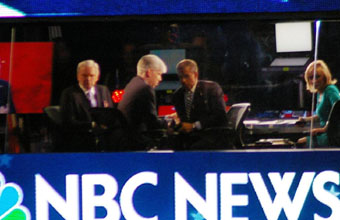
Book review by R. Alan Clanton
Thursday Review Editor

The Eclipse of Equality: Arguing America on Meet the Press; Solon Simmons. Launched near the close of World War II as a radio show—a sort of roundtable discussion between reporters and public figures, mostly politicians—Meet the Press quickly established its bona fides and imposing footprint in an age of new and expanding mediums. Despite a variety of formats ranging from multi-panelist to single moderator, it is now the longest running show ever to have been on television, very nearly surpassing all episodes of I Love Lucy, MASH, Gunsmoke and Bonanza combined.
By today’s lights, and in a world in which hundreds of millions worldwide get their news and information by watching the continuous cycle of CNN, Fox News, MSNBC, Bloomberg, al Jazeera or BBC, just to name a few, or by receiving and disseminating real time updates via their laptops, smart phones or other mobile devices, the idea of a once-per week show in the lazy, pre-sports hours of Sunday morning—a time slot once referred to by those who sold broadcast advertising as the TV “ghetto”—seems strangely quaint and even outdated…like a corded, rotary phone—or the “afternoon” edition of your local newspaper. Or perhaps my mint condition Members Only jacket.
But a well-written and thoroughly-researched new book by George Mason University instructor Solon Simmons, The Eclipse of Equality: Arguing America on Meet the Press (Stanford University Press, 2013), explores the continuing relevance of Meet the Press, a show which remains persistent and durable despite the global shift to instant breaking news, interminable crawls, Facebook and Twitter.
I experienced two stages of surprise when I became aware of this book’s release.
The first came merely with the book’s announcement: how could Simmons have filled over 250 pages, not including notes and references, with material salient and relevant to today’s news, or, more precisely, by Simmons’ criteria of measuring the great American democratic experiment with discourse and debate with the show’s effectiveness? Why not fast-forward to the study of Fox News or the predominance of red state versus blue state blogs? Surely the proliferation of continuous online opinion-making and real-time cable news represents what we now accept as the national “conversation.” So as a quick experiment I searched through our own Thursday Review “Road Show” and Politics Department articles dating back roughly six years—at least those I could account for on the hard drives of three computers and those edited in Microsoft Word (most of the articles from 2006-2009 are no longer available online though we plan to add them to our archives soon). The result of this informal search was an eye-opener: my own references to Meet the Press exceeded references to CNN, Fox News, MSNBC, CBS News, NBC News and ABC News. So I immediately ordered the book.
The second shock came when I first opened the book hours after it arrived. This was not what I expected, and that proved to be a good thing. Far from being a nostalgic retrospective or a straightforward, linear history of Meet the Press—which would have been not only the conventional approaches but also, perhaps, the more sales-driven formulas—Simmons’ book is about the larger tapestry of the American narrative, its debates, its struggles, and its maturity in the continuously evolving ages of radio, television, the internet and hand-held devices.
Anything but chronological in its approach, The Eclipse of Equality takes us through the great 20th century components of social, political and cultural change, moving us through chapters which explore—among other things—business-employee relationships and organized labor, science and technology in the context of the Cold War, the American experiment with exporting democracy and capitalism, and the always complex and difficult issue of race relations and its inevitable entanglements into economic competitiveness and political enfranchisement. Simmons explores with great care each of these subplots, examining those interviews and interactions from Meet the Press which show how, in many cases, less is more. In the small group or one-on-one formula, Meet the Press generally provided an opportunity for deeper conversation—often revealing far more truth than possible in the cacophony of the traditional press conference with its canned and rehearsed sound-bites, the sometimes meaningless choreography of political debates, or the mind-numbing chatter and distraction of the 24-hour news feed.
Simmons provides ample examples with excerpts from hundreds of programs in which reporters challenge political figures to illuminate and amplify; from labors leaders like Dave Beck to Jimmy Hoffa, to political figures like Bob Dole, Jack Kemp, Andrew Young, Jesse Jackson, John McCain, Clinton and Paul Ryan, to foreign policy chiefs like Colin Powell, Hillary Clinton, Madeleine Albright and Condoleeze Rice.
In the process, Simmons also contrasts the various moderators like Larry Spivak, Bill Monroe, Douglas Kiker, Roger Mudd, Tim Russert and David Gregory and their respective skills and styles as they seek to extract the core truths from their weekly guests. Gregory, the current host, took over after the sudden and tragically early death of the widely-beloved Russert in June 2008. Russert had been considered by many contemporary viewers the best of the moderators in recent decades, a reporter and questioner of impeccable balance and evenhandedness, and also a gifted inquisitor with what may have been the greatest skill at disarming the venue and deftly cutting the fat from the questions.
This is a highly readable and approachable book crafted to stand the test of time, just as its subject matter has stood for over half a century as the gold-standard for in-depth interview journalism. I recommend this book to anyone with a love of television journalism and its place in the great American experiment with participatory democracy.
Photo at top: Brian Williams (center) with David Gregory of Meet the Press, flanked by Tom Brokaw (left) and Andrea Mitchell (right) inside the NBC studio at the GOP convention, August 2012; photo by Alan Clanton.